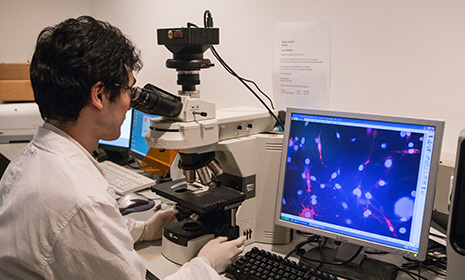潘烈文

於崇光基金教授(病毒學)
公共衞生病毒學講座教授
李嘉誠醫學院副院長(人力資本)
分部主任
公共衞生實驗室科學
- BSc(HKBU), MPhil(CUHK), DPhil(Oxon), FFPH (UK)
個人簡介
潘烈文教授是一名病毒學家和公共衞生科學家,於牛津大學威廉·鄧恩爵士病理學院接受博士培訓。畢業後返回香港,在香港中文大學從事博士後研究。他在2001年加入香港大學擔任研究助理教授,現於香港大學公共衞生學院擔任講座教授,同時亦是香港大學巴斯德研究中心的聯席總監。
潘教授的研究主要集中於引起人類健康問題的新出現和重新出現的病毒,例如SARS冠狀病毒、新冠病毒、中東呼吸綜合症病毒和人類與動物的流感病毒。他採用「健康一體」概念來研究動物與人類界面上的新興病毒。他開發了多種針對新出現的人畜共患流感病毒的分子測試,例如對 H5N1、2009人類型豬流感和 H7N9流感病毒的測試。他在2003年參與SARS冠狀病毒的發現和研究,並是最早破譯SARS冠狀病毒序列的人之一。他其後在野生動物中發現了許多不同冠狀病毒,其中包括第一種蝙蝠冠狀病毒。他在2009年H1N1流感大流行中在豬體內鑑定出了大流行H1N1/2009病毒的第一個重配體。他在新冠大流行期間作出重大的科學貢獻,並將這些科學發現應用於公共衞生實踐。他還對疫苗學研究有著濃厚的興趣。
潘教授發表了超過300篇同行評審文章。他是香港青年科學院的創始成員之一,並在2017年獲得裘槎基金會頒發的裘槎優秀科研者獎。根據Clarivate Analytics 的數據,自2005 年以來,他一直位居全球被引用次數最多的科學家的前1% 之列,引用次數超過44,000 次,H 指數為98。自2015 年以來,他還公認為高度引用的研究員。他於 2023 年獲得了巴斯德研究所頒發的路易斯·巴斯德二百週年獎,表彰他對抗新興傳染病的貢獻。
潘教授是多個國際組織的義務專家,並擔任世界衞生組織、聯合國糧食及農業組織和世界動物衞生組織的傳染病控制任務組內的義務顧問成員。他亦是《Virology Journal》的聯合主編。
發表的部分文章
- Gu H, Quadeer AA, Krishnan P, Ng DYM, Chang LDJ, Liu GYZ, Cheng SMS, Lam TTY, Peiris M, McKay MR, Poon LLM. Within-host genetic diversity of SARS-CoV-2 lineages in unvaccinated and vaccinated individuals. Nat Commun. 2023 Mar 31;14(1):1793. [2023 IF = 16.6] (Ranked 6 out of 73 under the category of “Multidisciplinary Sciences”) (Citation: 2)
- Yen HL, Sit THC, Brackman CJ, Chuk SSY, Gu H, Tam KWS, Law PYT, Leung GM, Peiris M, Poon LLM. Transmission of SARS-CoV-2 delta variant (AY.127) from pet hamsters to humans, leading to onward human-to-human transmission: a case study. Lancet. 2022 Mar 12;399(10329):1070-1078. [2023 IF = 168.9] (Ranked 1 out of 167 under the category of “Medicine, General & Internal”) (Citation: 73)
- Pan Y, Zhang D, Yang P, Poon LLM*, Wang Q*. Viral load of SARS-CoV-2 in clinical samples. Lancet Infect Dis. 2020 Apr;20(4):411-412. (*Co-corresponding authors) [2023 IF = 56.3] (Ranked 1 out of 96 under the category of “Infectious Diseases”) (Citation: 1014)
- Chin AWH, Chu JTS, Perera MRA, Hui KPY, Yen HL, Chan MCW, Peiris M, Poon LLM. Stability of SARS-CoV-2 in different environmental conditions. Lancet Microbe. 2020 May;1(1):e10. [2023 IF = 38.2] (Ranked 2 out of 96 under the category of “Infectious Diseases”) (Citation: 1211)
- Chu DKW, Pan Y, Cheng SMS, Hui KPY, Krishnan P, Liu Y, Ng DYM, Wan CKC, Yang P, Wang Q, Peiris M, Poon LLM. Molecular Diagnosis of a Novel Coronavirus (2019-nCoV) Causing an Outbreak of Pneumonia. Clin Chem. 2020 Apr 1;66(4):549-555. [2023 IF = 41.85] (Ranked 2 out of 29 under the category of “Medical Laboratory Technology”) (Citation: 747)
- Vijaykrishna D*, Poon LL*, Zhu HC, Ma SK, Li OT, Cheung CL, Smith GJ, Peiris JS, Guan Y. Reassortment of pandemic H1N1/2009 influenza A virus in swine. Science. 2010 Jun 18;328(5985):1529. (*Co-first authors) [2023 IF = 56.9] (Ranked 2 out of 73 under the category of “Multidisciplinary Sciences”) (Citation: 305)
- Poon LL, Chan KH, Smith GJ, Leung CS, Guan Y, Yuen KY, Peiris JS. Molecular detection of a novel human influenza (H1N1) of pandemic potential by conventional and real-time quantitative RT-PCR assays. Clin Chem. 2009 Aug;55(8):1555-8. [2023 IF = 41.85] (Ranked 2 out of 29 under the category of “Medical Laboratory Technology”) (Citation: 100)
- Poon LL, Chu DK, Chan KH, Wong OK, Ellis TM, Leung YH, Lau SK, Woo PC, Suen KY, Yuen KY, Guan Y, Peiris JS. Identification of a novel coronavirus in bats. J Virol. 2005 Feb;79(4):2001-9. [2023 IF = 5.4] (Ranked 11 out of 36 under the category of “Virology”) (Citation: 273)
- Guan Y, Zheng BJ, He YQ, Liu XL, Zhuang ZX, Cheung CL, Luo SW, Li PH, Zhang LJ, Guan YJ, Butt KM, Wong KL, Chan KW, Lim W, Shortridge KF, Yuen KY, Peiris JS, Poon LL. Isolation and characterization of viruses related to the SARS coronavirus from animals in southern China. Science. 2003 Oct 10;302(5643):276-8. [2023 IF = 56.9] (Ranked 2 out of 73 under the category of “Multidisciplinary Sciences”) (Citation: 1533)
- Peiris JS, Lai ST, Poon LL, Guan Y, Yam LY, Lim W, Nicholls J, Yee WK, Yan WW, Cheung MT, Cheng VC, Chan KH, Tsang DN, Yung RW, Ng TK, Yuen KY; SARS study group. Coronavirus as a possible cause of severe acute respiratory syndrome. Lancet. 2003 Apr 19;361(9366):1319-25. [2023 IF = 168.9] (Ranked 1 out of 167 under the category of “Medicine, General & Internal”) (Citation: 2047)








.png)
